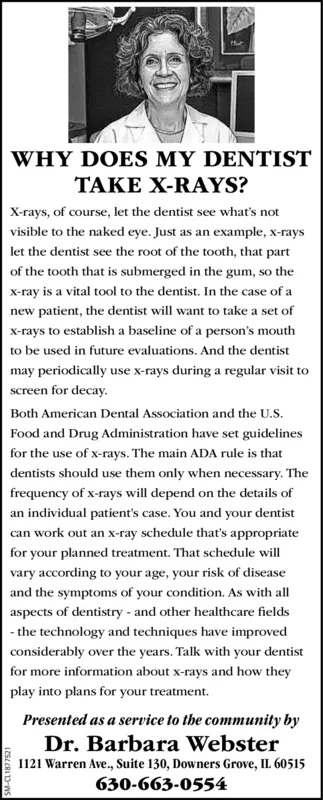Advertisement

-
Published Date
May 12, 2021This ad was originally published on this date and may contain an offer that is no longer valid. To learn more about this business and its most recent offers, click here.
Ad Text
WHY DOES MY DENTIST TAKE X-RAYS? X-rays, of course, let the dentist see what's not visible to the naked eye. Just as an example, x-rays let the dentist see the root of the tooth, that part of the tooth that is submerged in the gum, so the x-ray is a vital tool to the dentist. In the case of a new patient, the dentist will want to take a set of x-rays to establish a baseline of a person's mouth to be used in future evaluations. And the dentist may periodically use x-rays during a regular visit to screen for decay. Both American Dental Association and the U.S. Food and Drug Administration have set guidelines for the use of x-rays. The main ADA rule is that dentists should use them only when necessary. The frequency of x-rays will depend on the details of an individual patient's case. You and your dentist can work out an x-ray schedule that's appropriate for your planned treatment. That schedule will vary according to your age, your risk of disease and the symptoms of your condition. As with all aspects of dentistry - and other healthcare fields - the technology and techniques have improved considerably over the years. Talk with your dentist for more information about x-rays and how they play into plans for your treatment. Presented as a service to the community by Dr. Barbara Webster 1121 Warren Ave., Suite 130, Downers Grove, IL 60515 630-663-0554 SM-CL1877521 WHY DOES MY DENTIST TAKE X-RAYS? X-rays, of course, let the dentist see what's not visible to the naked eye. Just as an example, x-rays let the dentist see the root of the tooth, that part of the tooth that is submerged in the gum, so the x-ray is a vital tool to the dentist. In the case of a new patient, the dentist will want to take a set of x-rays to establish a baseline of a person's mouth to be used in future evaluations. And the dentist may periodically use x-rays during a regular visit to screen for decay. Both American Dental Association and the U.S. Food and Drug Administration have set guidelines for the use of x-rays. The main ADA rule is that dentists should use them only when necessary. The frequency of x-rays will depend on the details of an individual patient's case. You and your dentist can work out an x-ray schedule that's appropriate for your planned treatment. That schedule will vary according to your age, your risk of disease and the symptoms of your condition. As with all aspects of dentistry - and other healthcare fields - the technology and techniques have improved considerably over the years. Talk with your dentist for more information about x-rays and how they play into plans for your treatment. Presented as a service to the community by Dr. Barbara Webster 1121 Warren Ave., Suite 130, Downers Grove, IL 60515 630-663-0554 SM-CL1877521
